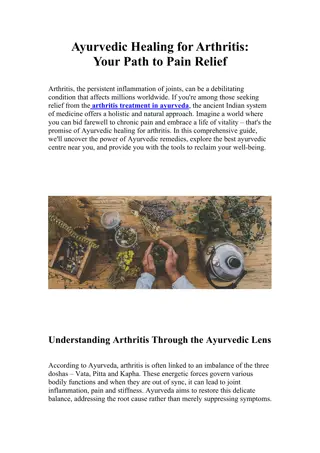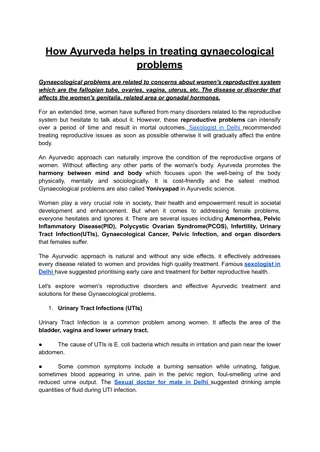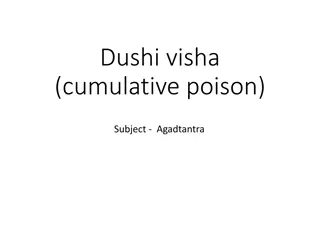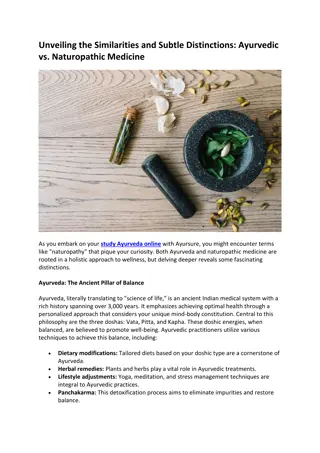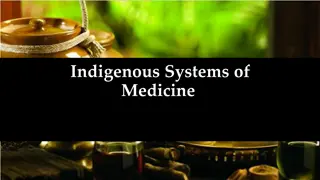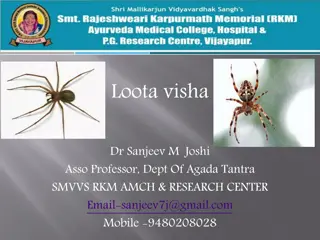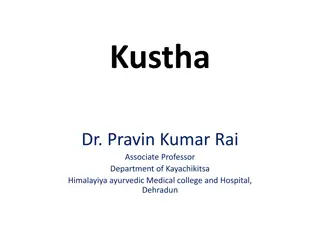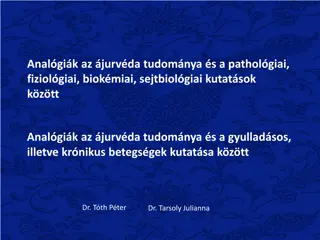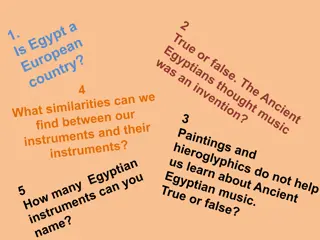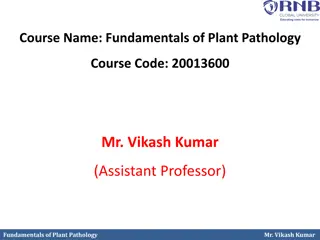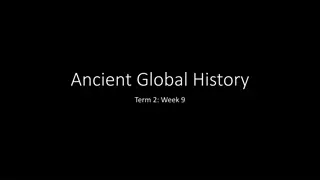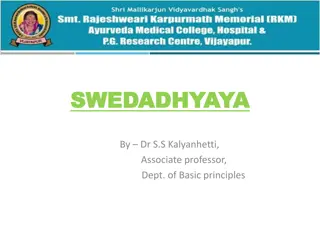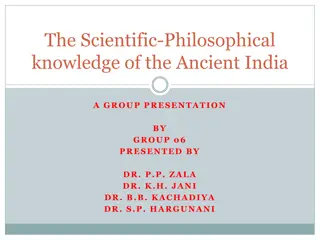Ayurveda: The Ancient Science of Life
Ayurveda, the dominant herbal tradition in India, is the oldest system of healing in the world. It integrates science, religion, and philosophy to maintain health and combat illness. Based on the concept of five basic elements and tridoshas, Ayurveda emphasizes the balance of these elements in the body for overall well-being. The presence or absence of this balance determines health or sickness, making nutrition a crucial aspect of Ayurvedic principles.
Download Presentation

Please find below an Image/Link to download the presentation.
The content on the website is provided AS IS for your information and personal use only. It may not be sold, licensed, or shared on other websites without obtaining consent from the author.If you encounter any issues during the download, it is possible that the publisher has removed the file from their server.
You are allowed to download the files provided on this website for personal or commercial use, subject to the condition that they are used lawfully. All files are the property of their respective owners.
The content on the website is provided AS IS for your information and personal use only. It may not be sold, licensed, or shared on other websites without obtaining consent from the author.
E N D
Presentation Transcript
AYURVEDA Ayurveda is the dominant herbal tradition in India. It still enjoys the faith of a large number of people of our country though it is perhaps , the oldest system of healing in the world. I t isencouraged in many countries like J a p a n , Germany etc
Definition The term Ayurveda is derived from two Sanskrit words , Ayur and Veda . Ayur means life and Veda means knowledge or science. Therefore Ayurveda means science of life or way of life.
Ayurveda incorporates s cience, religion and philosophy in it. Bes ides , dealing with principles for maintenance of health , it as also developed a wide range therapeutic measures to combat illness.
Principle The principle of Ayurveda is bas ed on the concept of five basic elements and tridoshas. According to Ayurveda, the whole universe made up of five bas ic elements ( Pancha mahabuthas)
The whole universe includes the material world, plant kingdom and all other living beings. In other words ,these five elements together form the basis of all matter. The five elements are Akasha (ether), Vayu ( air), Agni (fire), Jala(water), Prithvi (earth)
There is a balanced condensation of these elements in different proportions to suit the needs and requirements of different structures and functions of the body matrix and its parts. The growth and development of body matrix depends on its nutrition i.e.. on food. The food, in turn, is composed of above elements.
The health or sickness depends on the presence or absence of a balanced state of the total body matrix including the balance between itsdifferent constituents . The properties , location and manifestations of theseelementsare asfollows
Ether isnon resistance,it islocated in he body cavities like mouth, thorax, abdomen, lung cavity, digestivetract. Air is related to movements, vibrations and oscillations. They manifests movement of muscles, pulsation of heart, expansion and contraction of lungs, functioning of digestive and nervoussystems.
Fire concerned to radiation, it manifests digestion, metabolism, temperature, vision and intelligence. Water is related to force and cohesion. Located in cytoplasm, blood, salivary glands, gastric juice.
Earth is concerned to resistance and solidarity. They manifests skin, nails, hairs and bones. These elements manifest in the functioning of our scenes. They are also closely related to our ability to perceive and interact with environment.
TRIDOSHAS Thefive elements combine to form TriDoshas i.e Vata, Pitta, and Kappha. They are the Basic Forces and also known as the Pillars ofLife Vata (Air principle) the elements ether andair Pitta (Fire principle) the elements fire andwater Kapha ( Water principle) the elements earth and water
According to the Ayurveda , sicknessisdue to the imbalance of any one or more of the three doshas. Eg Aggravation of Pitta leads to indigestion, skindiseasesand liverproblems.
Factors Factors responsible for imbalance of doshas are physical, mental, spiritual and environmental may contribute for the imbalance of doshas
Diagnosis In Ayurveda diagnosis is always done of the patient aswhole. Diagnosis is carried out to find out which dosha is aggravated. For his purpose , nadi (Pulse),tongue , skin, physical features, stool, urine etcare examined.
Treatment The importance of treatment is to restore the balance and harmony of doshas with proper diet and drugs Selectionof the drugs Basedupon 1.Rasa(Taste),2.Virya (Potency) and Vipaka (Tasteafter digestion)
RASA Rasa indicates the composition, properties and and probable action of the drugs . There are six tastes. Each taste has one or more mahabuthas (elements) and each taste has its own influence on doshas. EgSweet( earth and water) ,influencesondoshas Kapha increases, vata and pitta deceases and promote antibiotic activities
Sour - (Water and fire) Pitta increases stimulates enzymes (Fire and earth)- Pitta increases Saline- (Air and fire) Pittaincreases Bitter - Pungent- (Air and ether)- Kapha and pitta decreases As tringent- (Air and earth)- Pitta decreas es and vatta increases
VIRYA On the basis of Virya, the drugs are classified into hot and colddrugs Hot (Ushna) drugs Aggravates pitta and pacifies vata and kapha, garlic,drumstick Cold (Sita) drugs Aggravates kapha and vatta and pacifies pitta , Jeera,amla
Vipaka Food and medicine undergoes various changes during digestion (metabolism). The taste after digestion is known as vipaka. The three tastes described under vipaka, sweet, sourand pungent.
S weet Aggravates kapha and alleviates pitta andvatha S our Aggravates pitha and alleviates kapha and vatha Pungent Aggravates vatha and alleviates kapha
INTRODUCTION There are so many alternative ways of treatment in whole world other than allopathy, which serve humanity for curing diseases & ailments that comes under the alternative systemof health care.
DEFINATION Those pathies which are widely used for the treatment of diseases in very natural way other than allopathy is known as alternative medicine of treatment
The process of treatment of these alternative medicine includes ancient types of procedure, have there unique features, unique ways of treatment of different diseases, unique principles & laws which they follow & also unique medicine, those totally different from allopathic medicine.
IN INDIA There are some pathies of alternative medicine which are widely used for treatment now a days include:- 1.Ayurvedic 2.Homoeopathy 3.Unani 4.Yoga 5.Sujok 6.Siddha 7.Naturopathy 8. Acupressure & Acupuncture.
HOMEOPATHY SYSTEM OFMEDICINE Homeopathy is relatively a recent system of medicine. The word Homeopathy is derived from two Greekwords, Homois meaning similar and pathos meaning suffering.
Homeopathy simply means treating diseases with remedies, prescribed in minute doses, which are capable of producing symptoms similar to the disease when they taken by the healthy people. It isbased on the natural law of healing. Similia Similibus Curantur which means Likesare cured by likes
ORIGIN AND DEVELOPMENT Homoeopathy is a s ys tem of medical Dr.Christian treatment introduced by Friedrich Samual Hahnenann, a German physician. he had spread a long and useful life of 88 years during which he benefited the suffering humanity immense by introducing thisnew systemof medicine.
DIFINATION & MEANNING Homoeopathy is a system of treatment (branch of medical science) works on the principle of Similia similibuscurenter . Means like cures like , further explanation is that patient & medicine symptoms are similar, it alsocalled LAW OFSIMILA
ABOUT THE FOUNDER DR.HAHNEMANN The Founder of homoeopathy was born on 10thApril, 1 755 at Meis s en in s axony of Germany. He was basically a M.D Medicine allopathic doctor who turned in to Homoeopath. He Died on 2nd july 1843.
DISCOVERY OFHOMOEOPATHY Because some dissatisfaction on that time about there practicing way of treatment i.e. allopathy, he relinquished ( to give up) the medical practice and devoted himself in translating the books, because Hahnemann had knowledge about the variouslanguage.
In 1790, when Hahnemann was engaged in translating materia medica his Cullen s attention was arrested by the remark of author that cinchona bark cured malaria because of its bitterness and tonic effects of stomach. This explanation appeared unsatisfactory to him. Hahnemann himself ingestedcinchona juice,
He was attacked by symptoms very similar to malarial fever. This unexpected result set up in his mind a new train of thoughts and he conducted similar experiments on himself and other individuals with other medicines whose curative action in certain diseases had been well established.
He found that in the healthy persons the medicine produce symptoms very similar to what they curein diseasesindividuals. Sohe had led to the inference that medicine cure disease only because they can produce similar symptoms in healthy individuals. The whole of homoeopathy derivesfrom thisLaw.
FUNDAMENTAL PRINCIPAL OF HOMOEOPATHY 1. Law of Similia 2. Law of Simplex 3. Law of Minimum 4. Doctrine of Drug proving 5. Theory of Chronic disease 6. Theory of Vital force 7. Doctrine of Drug-dynamization
Principle The cause of the disease itself can be its treatment i.e. Law of similar. This is the basic principle of homeopathy. According to Hahnemann, diseases are congenital and causedby genemutations. Toxic or poisonous substances are called Miasmsare responsiblefor gene mutation
Miasmsare of three types Psora Psychosis Syphilis Theseexist in a suppressed or sleeping state in a person. Aslong asthey are in that state, the person does not suffer from diseases due to resistancepower.
If any one of them stimulated , then the person loses his resistance power and suffers from diseases related to it. Therefore , Homeopathy iscalled a Geneticmedicine
Discoveryof drugs The drugs are discovered by testing on humans but not on animals . A drug is administered on healthy person to induce any one of the miasms and the symptoms of the drugsare discovered
Treatment The treatment is based on he concept of proving and prover Prover Thehealthy person Proving The symptoms (Physical, mental, emotional changes) that are caused by the various potenciesof medicinesin prover.
For the treatment , the symptoms of the drug are compared with the symptoms of the patient. In other words the selection of the drug depends upon the symptoms of the drug and patient condition.
The Unani System of Medicine hasa long and impressiverecordin India. It was introduced in India by the Arabs and Persians sometime around century. Today, India is one of the leading countries in so for as the practice of Unani medicine is concerned. It has the largest research educational, institutions. the eleventh number and of Unani care health
Origin & Development of UnaniSystem Unani systemoriginated in Greece Hakim Ajmal Khan IS UNANI physician but also one of the foremost freedom fighters in the country. He established an Ayurvedic and Unani Tibbia College and Hindustani Dawakhana a pharmaceutical company for Ayurvedic and Unani medicine in Delhi in 1916.
Today the Unani system of medicinewith hos pitals and educational and res earch institutions, forms an integral partof the national health care delivery system.
Principles & Concepts According to the basic principles of Unani the body is made up of the four basic elements i.e earth ,air, water, fire which have different temperaments i.e. cold, hot, wet, dry. After mixing and interaction of four elements a new compound having new temperament existence. i.eHot wet, hot dry, cold wet, and cold anddry.
The body has the simple and compound organs which got their nourishment ( The substances necessary for growth, health, and good condition ) through four humours i.e. blood, phlegm, yellow bile and blackbile.
The humour (put into a good mood) is also assigned temperament as blood is hot and wet, Phlegm is cold and hot, Yellow bile is hot and dry and Black bile is cold anddry.

 undefined
undefined









